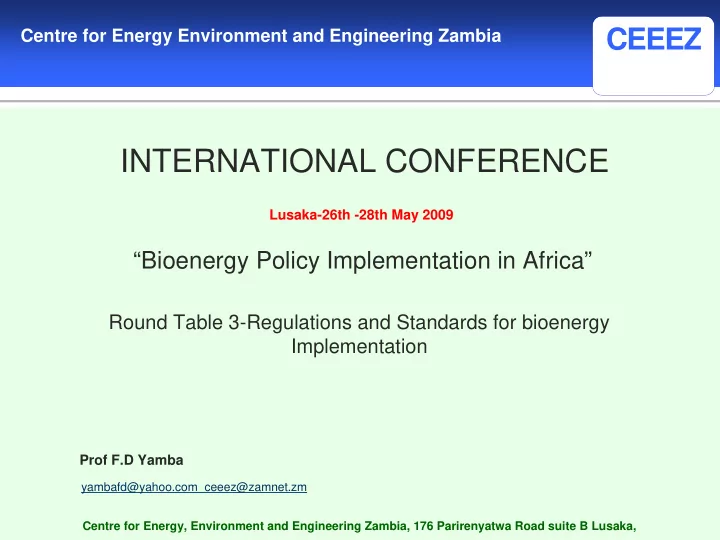

CEEEZ Centre for Energy Environment and Engineering Zambia INTERNATIONAL CONFERENCE Lusaka-26th -28th May 2009 “Bioenergy Policy Implementation in Africa” Round Table 3-Regulations and Standards for bioenergy Implementation Prof F.D Yamba yambafd@yahoo.com ceeez@zamnet.zm Centre for Energy, Environment and Engineering Zambia, 176 Parirenyatwa Road suite B Lusaka,
CEEEZ PRESENTATION OUTLINE • Overview • Issues for consideration during policy formulation - Relative differences between different fuels and their usage - Fuel standards and specifications - Engine modifications and performance - Conclusions 2
CEEEZ OVERVIEW Use of biofuels (bioethanol and biodiesel) has several implications for end use and distribution chain Specific biofuels and different blends offer advantages and disadvantages In view of this –such issues need to be considered when deciding policy frameworks and objectives of a biofuels market. Some of the policy considerations include; blending ratios; vis a vis- GHG emissions, engine modifications and related technical issues such as cold starting, vapour pressure, air quality, viscosity, public perception, infrastructure 3
RELATIVE DIFFERENCES BETWEEN CEEEZ DIFFERENT FUELS AND THEIR USAGE From the perspective of end use and distribution, bioethanol and biodiesel are attractive because they have close physical and chemical characteristics to fossil diesel and gasoline However, bioethanol and biodiesel are not exact analogies for petrol and diesel-For example bioethanol has lower heating value, vapour pressure, high oxygen content-which can be taken advantage of and use it as an octane enhancer to replace lead and/or MTBE Slightly more hydrophilic profile leading to corrosion of infrastructure. Biodiesel has slightly higher viscosity and standards difficult to keep due to widespread production possibilities. 4
CEEEZ FUEL STANDARDS AND SPECIFICATIONS Fuel standards play a major role in defining opportunities for biofuels through dictation of blending ratios There is therefore need for robust and clear systems for fuel standards and specifications which create consumer confidence Apart from providing standards which are available to fuel companies and car manufacturers Customers need to know and trust the safety of biofuels for engine effects and warranties However, situations where car manufacturers insist that no fuels can be used in their engines can create barriers for market development For these reasons, various countries specify different blending ratios – E2, E5, E20, E85-B2, B5, B20, B100 and corresponding standards 5
CEEEZ FUEL STANDARDS AND SPECIFICATIONS Some of special technical features which go into standards include for example for biodiesel , greater chain length of biodiesel than fossil diesel resulting in lubricity being compromised for biodiesel as it penetrates into the crankcase through the piston rings. For bioethanol, a key challenge especially during cold periods in winter –typical of northern countries –is the lower vapour pressure Vapour pressure reduces as ethanol content in blends increase- resulting in ignition difficulties especially in colder regions. 6
CEEEZ ENGINE MODIFICATIONS AND PERFORMANCE Engine modifications/developments are essential as blending ratios increase –such as carburator/Fuel injection systems, fuel filters, ignition systems, change of lubricants, basic engine design, cold start systems. Bioethanol for example (Based on Brazilian example) -up to E5 (no necessary modifications), E5-E10(carburator modification for vehicles upto 12-20 years old), E10-E25(carburator/fuel injection systems, ignition systems, fuel pressure devices and fuel filters), E25-E85, and above E85 specially designed engines A typical example for specially designed engines-Flex-Fuel Engines (FFVs) which alternate between two sources of fuel • Between petrol and bioethanol • Petrol and natural gas-Brazil providing leadership FFVs are designed with higher compression ratios and flexible ignition systems resulting in improved fuel efficiency and reduced emissions 7
CEEEZ CONCLUSIONS To develop a regulatory framework and set standards requires; • In depth understanding of various technical issues • Provide clear information about the physical and chemical characteristics (energy density, oxygenate levels, octane number, cetane number, hydrophilic effects • Provided clear information on types of fuels that is recommended • Future engine developments will require to be energy and environmentally efficient • Gradually adapt and optimise for higher blend biofuels 8
END OF PRESENTATION CEEEZ THANK YOU END OF PRESENTATION 9
Recommend
More recommend